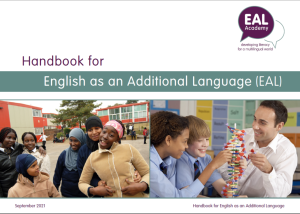To help EAL learners feel secure, valued, and socially included so that they can progress more quickly:
- give the learner a seat towards the front of the classroom, in view of board.
- make use of display, books and artefacts that reflect the learners’ language/ ethnic background
- differentiate and allow sufficient time for pupils to complete tasks
- consider pupil grouping to allow for collaborative learning and to provide peer support
- allocate roles in groups, e.g. reporter, photographer, time-keeper, note-taker, questioner etc. to ensure participation
- ensure pupils have the relevant equipment and can see the textbook and demonstration
- give the learner well trained buddies to help them find their way around.
To make the curriculum accessible:
- activate prior knowledge
- ensure examples are culturally diverse
- provide visual or concrete support such as pictures, videos, examples, real objects
- allow time for pre-teaching if you have support
- give the pupil a hard copy of any presentation used
- use graphic organisers to display text, e.g., a timeline.
To check for understanding:
- use non-verbal communication, smile and make gestures.
- structure listening activities and provide scaffolding such as tick charts for key words for support
- let the pupil use traffic light cards to show if they are following
- ask closed (yes/no) questions
- give concrete activities such as sorting pictures into vertebrates and invertebrates
- encourage and enable the use of first language to support learning
- plan for active learning and observe the pupil.
Most of all, be patient!
All of these ideas are from The EAL Handbook, where you will find lots of useful checklists and practical advice.

